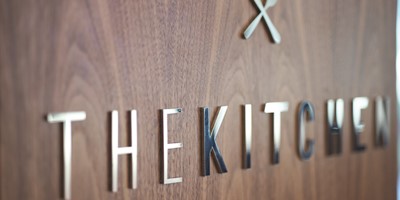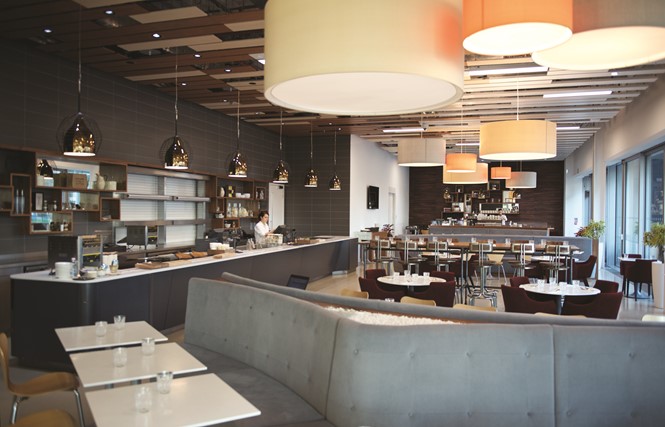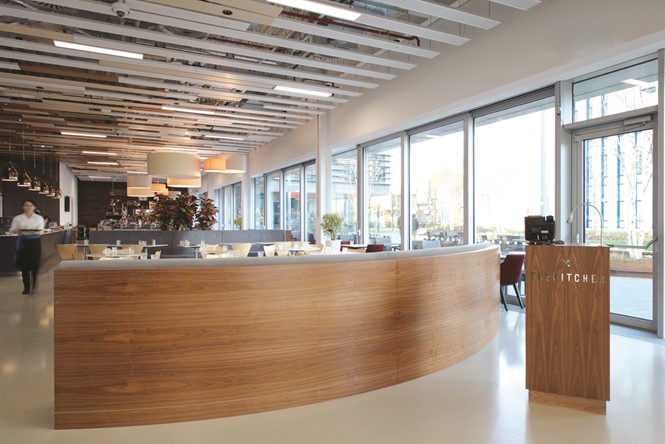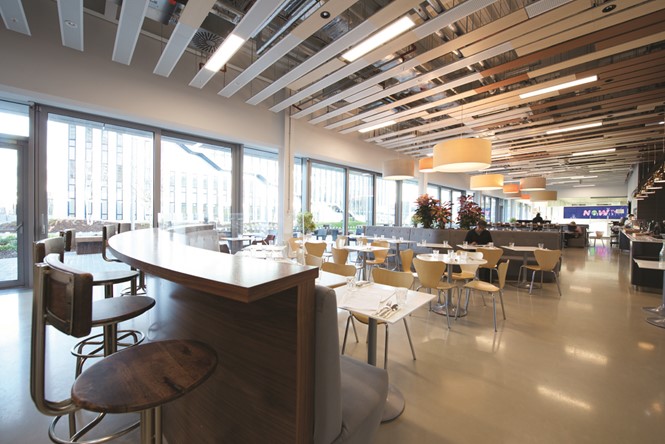Brand experience: Sky
The built environment is one of the key brand touchpoints for the internal audience. Sky shows how a company can revolutionise its internal brand experience through attention to detail, food and cultural change. Emily Andrews reports
With its campus in Osterley, London, UK telecoms company, Sky, intends to create a hub of activity, a community and an on-brand environment for its employees. Its recent improvements include the ‘Believe in Better’ building – the UK’s tallest commercial timber structure, by Arup Associates – and the launch of new dining areas, by Sedley Place, which are intended to offer more than a traditional office canteen. Inspired by high street eateries and fashionable restaurants, Sky’s new food areas help to create an environment where its employees want to socialise and spend their time, all while encapsulating the Sky brand.
Mick Nash, managing director at Sedley Place, the creative consultancy responsible for designing Sky’s new restaurant concepts, says, “These environments are elevated to be not just places that serve food, but that are actually great places to be. They become cultural meeting places, work environments, [sites for] ad hoc events; places where you want to socialise and meet colleagues. They become places where you want to spend time rather than just eat meals.”
Sky aims to instil its brand proposition, ‘Believe in Better’ in everything that it does. Nash says, “I think its endemic in Sky’s particular brand that it challenges itself to think differently, to look within itself, as well as externally, and to challenge norms and explore the possible. In all of the projects that I’ve been involved in, Sky has absolutely demonstrated that self- questioning, ‘Believe in Better’ attitude.”
With the campus environment in particular, there is a unique opportunity engage employees with the Sky brand. By its nature, the campus is holistic, with a similar environment to a university – it includes social, as well as learning spaces. Because it is situated in a fairly residential area in outer-west London, it is important that the campus feels like a hub, and provides Sky employees with that social element. A campus environment is particularly advantageous for a company such as Sky, as its employees tend to belong to a relatively young demographic. Like Google, a company that is famous for its campus-style work environments, Sky is a tech company that likes to be perceived as cutting edge, modern and ahead of its time. Similarly, its digitally-savvy employees tend to be of the generation that favour the modern, always switched-on approach to work. The campus environment enables that style of working.
Nash says, “If you think about the way that people work these days; the way that younger generations in particular think about work, they have a much more blurred line between what is work and what is social activity. They don’t mind being on their phone socially and work at random times of the day and they don’t have a very clearly defined, ‘At 9:30 I start work, and at 5:30 I stop,’ view of the world. They just don’t. By doing this kind of thing we’re reflecting the way that younger generations of employees are already living their lives.”
“These environments are elevated to be not just places that serve food, but that are actually great places to be. They become places where you want to spend time rather than just eat meals”

By making the campus a place where its employees want to spend their social time, as well as their working hours, Sky encourages an always-on attitude, stronger brand engagement, and it enables better conversations among colleagues. Two of the new spaces designed by Sedley Place; the Loft and the Kitchen, are designed to function as restaurants in the day, and become social spaces in the evening. For Sky, it was important that its campus remain an open and pleasant place to be at any time since the broadcasting company runs 24-hours-a-day and many of its employees don’t work the traditional nine-to-five.
Catering business Gather & Gather, which supplies Sky’s food and beverage offering, along with Sedley Place and Sky, conducted research prior to the restaurant development to better understand Sky employees and their needs and preferences. The research demonstrated the popularity of the venues as they stood, and provided some insight into what might be lacking. Next, all three organisations conducted on- the-ground research, to get a better understanding of the retail sector and to learn from its successes.
Nash says, “We did a lot of work outside of the campus – in central London, in Soho – to see what was new and exciting in food and beverage; not just in terms of the delivery of the food, but also the type of environment and the point of service.” This helped the organisations to get a feel for the styles of service that are currently most popular with the demographic with which they were looking to engage, and it gave them a better understanding of the ways in which specific atmospheres are created.
The Kitchen’s creative inspiration comes from post-industrial buildings with exposed structures, suspended lighting and curved banquette seating. With a maître d’ to seat customers, and an artistic, creative environment, the space is designed to have the look and feel of a fashionable high street restaurant. The Kitchen offers a classic British menu using high quality produce.
The other new space, the Loft, has a studio-like feel that emphasises its exposed timber structure. Urban furniture, oiled wood floors, a steel-panelled bar and counters with suspended industrial lighting are intended to give the space an east London feel. The eating areas embody the same attention to detail and space as the rest of the Sky campus. The creative concept for the Loft amplifies the space’s height and its rooftop views. The Mediterranean fare at the Loft inspires a more informal atmosphere than that of the Kitchen. The new spaces are characterful and unique in the environments they provide.
Sedley Place, which had previously designed seven other Sky restaurants in London and Scotland, also helped to devise a new brand look for the Kitchen – including a logo featuring a crossed knife and fork symbol and a bold, capitalised typeface – which will be used across print materials and on signage. Nash says, “We chose the furniture, fittings and overall design to create
an ambiance that appealed to both hearts and minds and to complement Gather & Gather’s excellent food offer.” While the new spaces are strongly tied to the Sky brand, some also have their own, distinctive sub-brand identities. This helps to ensure that each space has its own unique qualities so that there is a space for every employee and for every occasion; whether it be a formal meeting or a casual get-together. Branding also helps to ensure that the Kitchen feels professional, like a restaurant, rather than an office canteen.
The Kitchen and the Loft opened in August 2015. Since, the popularity of the new venues and increased footfall and dwell time ensure the substantial investments that were presumably made in this project drive ROI in the long term. Previously, food and beverages were sold at the lowest possible price point, but the new offering has added value. It was ascertained prior to the creation of the new eating areas that food was ranked highly by Sky employees in terms of providing a nice place to work. It was therefore safe to assume that they would be willing to pay more in exchange for food and eating environments of a superior quality, or that they would at least appreciate the choice.
Beyond increased sales, the new destinations are valuable to Sky from an employer brand and employee engagement perspective. Whereas before, employees tended to socialise outside of the Sky campus, they are now much more inclined to spend more time on-site, which builds brand engagement and encourages a team mentality. Both of which are powerful tools for a major brand to have at its disposal.
Another positive outcome of the brand environments is the health aspect; the new menus favour a healthy and balanced diet which will have a positive effect on the wellbeing of Sky employees. The new spaces have also been popular with the general public and there has been a high demand since their launch, with tables booked well in advance. Thus, the new eating areas may even help to build brand engagement with external audiences. Sky continues to build its image as a young, cool and forward-thinking brand.
Nick Green, property service group director at Sky, says, “Our new restaurants have been designed for Sky. They fit with our overall environment and while not shouting ‘Sky.’ They feel very in keeping with who we are and with our ‘Believe in Better’ ethos.”
Nash agrees, “It’s not a heavy message, Sky just provides the facility and lets [the employees] engage. It’s living, walking and talking the brand.” The campus improvements thus work on a macro, as well as a micro, level.
It is this commitment to its defining principles that makes Sky a success. To an outsider, workplace eating areas may not seem like the most crucial area of investment, but the telecoms giant knows that brand has to be lived and breathed at every single touchpoint. Employees are an organisation’s greatest asset, and their wellbeing and brand loyalty are essential. Sky’s modern campus model will likely be emulated by more companies as the average worker’s approach to work/life balance continues to evolve.















